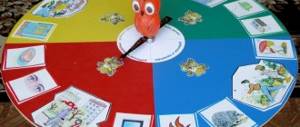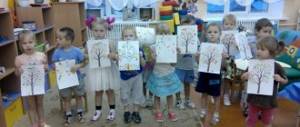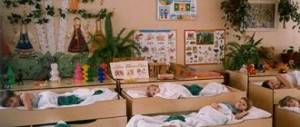Long-term plan for the “Masterilka” club for children in the pre-school group
Explanatory note.
Manual creativity is a type of activity through which skills and abilities, mental and aesthetic development are especially quickly improved. Children with well-developed mastery skills develop speech faster, since fine motor skills of the hands are connected to speech centers. Dexterous, precise hand movements give the child the opportunity to quickly and better master writing techniques.
A child is a born designer, inventor and researcher. These inclinations inherent in nature are especially quickly realized and improved in this type of activity. After all, the baby has an unlimited opportunity to come up with his own designs, showing curiosity, intelligence, ingenuity and creativity.
In the process of manual labor, performance increases, blood circulation improves, and coordination of hand and eye movements develops. When making crafts, children actively use tools, use them for their intended purpose, learn to recognize the properties of materials, compare them by shape, size, depending on the purpose, size of the craft.
The child develops an idea of categories such as size and shape. He learns from experience the structural properties of parts, the possibilities of their fastening, combining, and design. At the same time, as a designer, he creates, learns the laws of harmony and beauty.
Children who are interested in manual labor are distinguished by their rich imagination and imagination, the desire to experiment and invent. They have developed spatial, logical, mathematical, associative thinking, memory, and this is the basis of intellectual development and an indicator of the child’s readiness for school.
Purpose of the circle:
Development of children's cognitive, constructive, creative and artistic abilities in the process of creating crafts using various materials and techniques.
Tasks:
Teach children various techniques for transforming paper, fabric, natural and waste materials.
Learn in advance, plan the progress of work on the product (establish a logical sequence for making the craft).
Learn to identify work methods and tools, and navigate the task independently.
To develop the ability to take into account the specific properties of materials when making crafts from them.
To develop creative imagination, fantasy, ingenuity, the ability to establish cause-and-effect relationships, cognitive interests and creativity, constructive skills, aesthetic taste.
Develop fine motor skills of the hand, general hand skill, coordination of hand and eye movements.
Develop sensory standards of shape, size, color.
Improve communication skills.
Activate and enrich children's vocabulary, play experience and create conditions for self-expression and expansion of social experience.
Create conditions for positive emotions.
To cultivate diligence, accuracy, and the desire to complete the work started.
Methods and techniques of teaching.
1. Visual (showing a sample teacher, example, multimedia slide show, help).
2. Verbal (explanation, description, encouragement, persuasion, use of tongue twisters, proverbs and sayings, conversation, story, fairy tale).
3. Practical (independent and joint performance of crafts).
Preparation of a subject-development environment:
Paper of different formats, colors, quality, colored cardboard;
Paints, glue, scissors, varnish, plasticine, felt-tip pens, pencils, brushes;
Natural material: grains, peas, seeds, etc.
Waste material: threads, buttons, rhinestones, beads, beads, feathers, cotton wool, matches, fabric, etc.
Class structure:
- Formation of positive motivation for work;
- Examination of samples, discussion;
- Building an action plan (“what’s first, what’s next”);
- Material selection;
- Finger gymnastics;
- Independent work of children;
- A physical activity moment or a game with a craft.
- Analysis of the finished work.
The comprehensive thematic plan is designed for 1 year.
Direct educational activities in the evening, 1 time per week, 4 classes per month, 36 classes per year.
Long-term work plan for the “Masterilka” circle
in the preparatory school group
September
| № | GCD | Target | Material | Watch |
| 1. | Organizational: “Acquaintance with a diverse world of materials." | To develop positive motivation in children in the activities of the circle. Provide children with the opportunity to see the variety of materials from which crafts can be made, and create a desire to experiment with it, identifying properties and connections. | Paper, cardboard, plasticine, fabric, seeds and fruits of plants: acorns, chestnuts, bark, branches, seeds, leaves, shells, feathers. | 1 |
| 2. | "Let's go mushroom picking" | Continue to teach children how to sculpt mushrooms of different shapes and convey their characteristic features. Strengthen the smoothing technique. | Plasticine, board, stack, samples of mushrooms in pictures | 1 |
| 3. | "Magic Paper" | To introduce children to the Japanese art of origami and to develop an interest in it; develop in children the ability to work with their hands, accustom them to precise finger movements under the control of consciousness; develop spatial imagination (learn to read drawings); strengthen the ability to follow oral instructions; develop concentration and creativity. | Colored paper, scissors, pencils. | 1 |
| 4. | “As a gift to our grandparents” | Make greeting cards using a template. Teach independence and accuracy | Colored paper, scissors, pencils. | 1 |
October
| № | GCD | Target | Material | Watch |
| 5 | "Autumn paintings" | Teach children to create plot compositions, cultivate a desire to preserve the beauty of nature in arrangements and floral compositions. | Leaves of various trees and shrubs, herbs, flower petals, seeds, colored cardboard, glue, brushes, napkins, oilcloths, composition options. | 1 |
| 6 | 1 | |||
| 7 | "Fairytale Heroes of the Forest" | Continue teaching children to work with natural materials. Teach children to make crafts based on drawings, combine different materials in one craft, and fasten them together using sticks and plasticine. Develop creative imagination, fantasy, cultivate artistic taste, patience, attention, observation. | Spruce, pine, alder, chestnut, acorns, ash wings, down and bird feathers, plum and apricot pits, moss, various seeds. Demonstration drawings with crafts. | 1 |
| 8 | 1 | |||
| 9 | Modeling toys according to children's ideas. | Teach children to independently select a topic for work, using their existing experience in creating crafts from natural materials. | A variety of natural materials, plasticine, wire, stacks, planks. | 1 |
| November | ||||
| № | GCD | Target | Material | Watch |
| 10 | "Magic plates" | Develop a sense of form, color and composition; creative imagination, artistic taste, creative initiative. | Paper plate, colored paper, paints glue, scissors, sample. | 1 |
| 11 | "In Grandma's Yard" | Create a collective model of a village yard using origami techniques. Develop children's spatial imagination, strengthen the ability to follow oral instructions; develop concentration and creativity. | Colored paper, scissors, pencils, cardboard box, scraps of fabric. | 1 |
| 12 | 1 | |||
| 13 | "Doll made of colored yarn" | Teach children the simplest way to transform yarn into a souvenir doll, and independently use the decorative elements of a craft. | Colored yarn, scissors, colored paper, glue, sample. | 1 |
December
| № | GCD | Target | Material | Watch |
| 14 | "The Long-awaited Guest" | Teach children to make a three-dimensional Christmas tree from a cone and colored stripes of the same length | Colored paper (green), cardboard, scissors, glue, sample. | 1 |
| 15 | "New Year's toys" | Strengthen children’s previously acquired skills in working with paper, glue, and scissors; develop a sense of form, color and composition; develop creative imagination, artistic taste, creative initiative. | Colored paper; cardboard templates of geometric shapes; scissors; braid for making loops; glue; tassels; paints; jars of water; napkins, corrugated paper, confetti. | 1 |
| 16 | 1 | |||
| 17 | "Volume snowflakes" | Teach children to make a three-dimensional snowflake and connect the parts. Develop creative imagination, fantasy, cultivate artistic taste, patience, attention, observation. | White paper, glue, pencil, scissors, loop tape, sample. | 1 |
| January | ||||
| № | GCD | Target | Material | Watch |
| 18 | "Winter's Tale" | Create a collective panel. Teach children to crumple small pieces of paper, glue them onto templates, thereby developing fine motor skills, develop creative imagination, fantasy, and use different techniques for working with paper and cotton wool. Strengthen children's previously acquired skills in working with paper, glue, and scissors. | Whatman paper A3, pencil, colored paper, toilet. paper, napkins, serpentine, corrugated paper, foil, cotton wool, cotton pads, glue, scissors. | 1 1 |
| 19 | ||||
| 20 | "My first bookmark" | Develop thinking, spatial imagination, memory, fine motor skills and speech | Colored paper, pencil, scissors, glue, sample. | 1 |
February
| № | GCD | Target | Material | Watch |
| 21 | Greeting card for Defender of the Fatherland Day. | Learn to think about the content of a postcard, use a variety of cutting techniques. Learn how to beautifully arrange an image on a sheet of paper. | Sheets of thick paper, templates, colored paper, scissors, glue, brush, braid, oilcloth, sample. | 1 |
| 22 | 1 | |||
| 23 | Gift for mom. | Continue teaching children how to make three-dimensional crafts | Colored, white, corrugated. paper, scissors, glue, pencil, openwork braid, tassel, sample. | 1 |
| 24 | 1 |
March
| № | GCD | Target | Material | Watch |
| 25 | "Little Beads" | Introduce children to this type of artistic creativity, such as beadwork, and teach them how to make a simple bead decoration. Develop imagination, fine motor skills, coordination of movements, finger flexibility, which is directly related to speech and mental development, teach concentration and diligence. | Multi-colored beads of different sizes, thin fishing line (thread), scissors. | 1 |
| 26 | 1 | |||
| 27 | "Blooming tree" | Teamwork. To consolidate children's previously acquired beadwork skills. Teach cooperation and careful execution of crafts. | Multi-colored beads of different sizes, thin fishing line (thread), wire, scissors, stand for “tree”, gouache paint, gauze, plaster, glue, brush. | 1 |
| 28 | 1 |
April
| № | GCD | Target | Material | Watch |
| 29 | "Easter Bunny" | Making a “bunny box” for an egg using the origami method and coloring an Easter egg. To develop in children the ability to work with their hands, to accustom them to precise finger movements under the control of consciousness; develop spatial imagination, strengthen the ability to follow oral instructions; develop concentration and creativity. | Colored paper, glue, pencil, scissors, brush, eggshell, paint, sample. | 1 |
| 30 | 1 | |||
| 31 32 | "Miracle Curl" | Introduce children to a new type of working with paper - quilling. To develop in children the ability to work with their hands, to accustom them to precise finger movements, to develop spatial imagination, to consolidate paper rolling skills, to develop concentration and creativity. | Quilling paper of different colors, pencil, scissors, cardboard, glue, sample. | 1 1 |
May
| № | GCD | Target | Materials | Watch |
| 33 | Greeting card for Victory Day | Learn to think about the content of a postcard, use a variety of cutting techniques. Learn how to beautifully arrange an image on a sheet of paper. | Colored paper, colored cardboard, pencil, scissors, glue, sample. | 1 |
| 34 | 1 | |||
| 35 | "Whisper of the Sea" | Continue to teach children to work with natural materials - shells. Teach children to make crafts based on drawings, combine different materials in one craft, and fasten them together using plasticine. Develop creative imagination, fantasy, cultivate artistic taste, patience, attention, observation. | Shells of different types, plasticine, beads for eyes. Demonstration drawings with crafts. | 1 1 |
| 36 |
List of used literature:
1. Rumyantseva E. A. Unusual crafts from natural materials - Bustard, 2007
2. S. Sokolova School of origami. Applications and mosaics. – Moscow: Eksmo 2005.
3. E.K. Gulyants, I.Ya. Basic. What can be made from natural materials: a book for kindergarten teachers. 2nd ed. M.: Education, 1991.
4. Yu. A. Bugelsky. Homemade toys. Ed. M.: Education, 1965.
5. Tkachenko T.B., Starodub K.I. We weave trees from beads. Rostov n/d.: Phoenix, 2006.
6. N. Krotkova. Book of the best crafts, Rosman-Press, 2006.
7. Selezneva E. V. Flowers and toys made of rolled paper: Quilling for kids. — Litera, 2012
8. Tsygvintseva O.A. Workshop of folk dolls. Theoretical and practical principles of manufacturing. — 2013. St. Petersburg.
Goals and objectives of the additional education program “Gramoteyka”
So, extracurricular activities to prepare children for school are usually held in the preparatory group, but it’s not a sin to start earlier. Lessons, if you can call them that, are taught once or twice a week. Attending the circle is voluntary, at the request of the parents. At the discretion of the kindergarten, these can be free or paid classes.
If the additional education program developed by the kindergarten provides for a literacy club in the senior and preparatory groups, then classes are provided once a week after naps.
Why is a literacy club needed in kindergarten?
To prepare kids for writing, you need to start introducing them to sounds before they start writing letters. If children do not distinguish sounds, cannot distinguish them, or pronounce them correctly, then in 1st grade they will have great difficulties with writing. The technology of teaching in additional education clubs involves teaching children to hear, distinguish, differentiate, and correctly pronounce the sounds of their native speech.
The goal, in short, is to prepare preschoolers for literacy.
Tasks in detail - training, development, educational:
- Acquaintance with letters, basic linguistic concepts (word, sound, letter);
- Do a simple sound-letter analysis of words;
- Compose sentences and words according to a given model;
- Develop broad phonemic awareness and hearing;
- Make simple graphic notes of words and sentences;
- Develop communication skills, vocabulary, correct speech and respect for the native word;
- Prepare your hand for writing.





